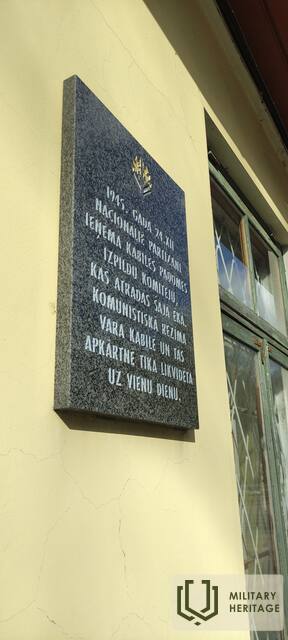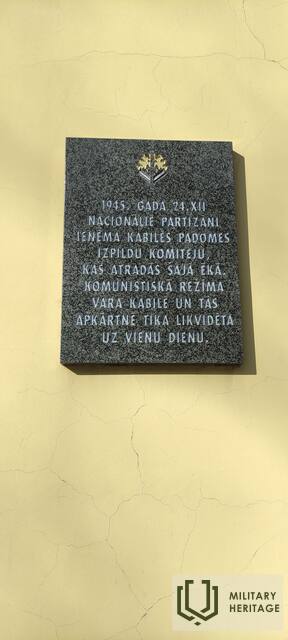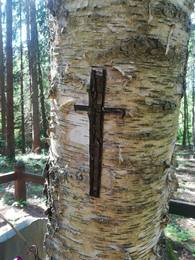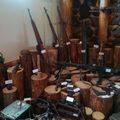Kabyle užėmimas 1945–1946 m. sandūroje
Vienas ryškiausių pokario ginkluoto pasipriešinimo Kuržemėje apraiškų buvo Kabilės užėmimas per 1945 m. Kalėdas ir vėlesnis mūšis prie Āpuzniekių namų 1946 m. sausio 1 d.
Buvusiuose Kabilės parapijos namuose buvo įsikūręs vietos vykdomasis komitetas ir policijos nuovada, kur naktimis budėjo apie 25 ginkluoti milicininkai ir naikintojai. Išpuolio pretekstas buvo noras paleisti miško brolį Rūdolfą Eglītį, kuris buvo sulaikytas ankstesnę dieną ir jau naktį perkeltas į Kuldygos policijos nuovadą.
1945 m. gruodžio 24 d. ankstų rytą 20 ginkluotų partizanų pasiskirstė į kelias grupes, nukirpo telefono laidus, užblokavo kelius ir įsikūrė už 300 metrų nuo Kabilės centro esančiuose postuose.
Atidengę ugnį, atskira puolimo grupė pro langus įsiveržė į policijos patalpas, juos išmušdama su visais rėmais. Policininkai buvo pastatyti prie sienos pakeltomis rankomis, o šalia jų paliktas sargybinis, o kiti partizanai užbėgo į antrą aukštą, kur buvo pabėgę Kuldygos naikintojų bataliono Kabiles būrio kovotojai. Nors buvo galimybė juos nužudyti rankinėmis granatomis, to nepadarė, kad nenukentėtų partizanų rėmėjo – vykdomojo komiteto sekretoriaus, gyvenančio visai šalia, šeima.
Remiantis vėlesniu Latvijos SSR Valstybės saugumo ministerijos Kuldygos rajono skyriaus viršininko Sobačkino pranešimu, 1945 m. gruodžio 24 d. Kabile nuo miško brolių kulkų žuvo Valstybės saugumo liaudies komisariato (VDTK) Kuldygos rajono skyriaus operatyvinis karininkas Dambis ir vairuotojas Purinis bei eskadriniai minininkai „Liepiņš“ ir „Znotiņš“, o VDTK Kuldygos rajono skyriaus vyresnysis leitenantas Kirsanovas, operatyvinis karininkas Baļuļinas, eskadrinis minininkas Galeckis ir milicijos karininkas Ziedsas. Vietinė partijos sanitarė Budanska, pasislėpusi už krosnies, susirėmimo metu išgyveno.
Partizanai paėmė pagrobtus ginklus kaip trofėjus, konfiskavo vykdomojo komiteto dokumentus ir rašomąsias mašinėles, o suimtuosius paleido.
Kaip partizanai 1945/1946 m. išvijo okupantus iš Kabilos / Straipsnis (lsm.lv)
https://www.lsm.lv/raksts/dzive--stils/vesture/ka-partisans-19451946-gadumija-padzina-okupantus-no-kabiles.a490270/
Susijusi laiko juosta
Susijusios temos
Susijusios vietos
Nacionalinių partizanų kovų vieta netoli Apūzniekų namų
1946 m. sausio 1 d. tarp Kabilos ir Rendos, netoli „Apūzniekų“ namų, įvyko vienas didžiausių mūšių tarp nacionalinių partizanų ir Čekos, arba sovietų okupacinio valstybės saugumo komiteto. Partizanai, tarp kurių buvo ir grupės vadas Fricis Kārkliņš, miško brigadų arkliais jojo šieno. Vadu jis paliko Ēvaldą Pakulį. Žvalgai pranešė, kad prie žeminių artėja Čekos dalinys. Pakulis pasiuntė jų pasitikti partizanų būrį – 25 gerai ginkluotus vyrus. Priešo kulkos pražudė tris vyrus – Kārlį Kristoldą, Emītis Šmitą ir Adolfą Kūrėjų – tačiau Čekos pusėje žuvo apie 50 vyrų. Du žuvę vyrai palaidoti miške, kur kadaise vyko šie įvykiai, ir jiems sukurtas memorialas.
Šiandien miškuose atrandami nauji bunkeriai, kuriuose kadaise glaudžiasi beveik 20 000 žmonių, kurie nepritarė sovietų okupacijai ir nenorėjo bendradarbiauti arba slėpėsi miškuose dėl kitų priežasčių, pavyzdžiui, baimės dėl savo gyvybės, saugumo ir pan.
Rendos nacionalinio pasipriešinimo judėjimo muziejus
Muziejus yra įsikūręs už kelių kilometrų nuo Rendos parapijos centro. Parodoje pasakojama apie 50 metų trukusį pasipriešinimo judėjimą Latvijoje: pasipriešinimą pirmajai sovietų okupacijai, pasipriešinimą nacistinės Vokietijos okupacijai ir ginkluotą bei nesmurtinį pasipriešinimą sovietų okupacijai. Paroda įsikūrusi dviejuose pastatuose. Pirmajame pastate saugomi pirmosios sovietų ir vokiečių okupacijos įrodymai. Parodoje eksponuojamas restauruotas tvarto pastatas, kuriame dėmesys sutelktas į Nacionalinį partizaninį karą. Tarp dviejų pastatų yra autentiško išplanavimo bunkeris ir kareivių naudoti apkasai. Netoli muziejaus Rendoje esantys kasinėjimai, blindažo aikštelė ir kliūčių ruožas tarnauja kaip jaunimo sargybinių ir visų susidomėjusiųjų treniruočių aikštelė. Apsilankymus būtina užsisakyti iš anksto.
Vienas didžiausių nacionalinių partizanų mūšių, vadinamas Āpūzniekų mūšiu, įvyko 1946 m. sausį netoli čia. Mūšyje Kabilės nacionalinis partizanų būrys nugalėjo daug didesnes okupacinės valdžios pajėgas. Mūšio vietoje, kurioje yra informaciniai stendai, dabar įrengta poilsio aikštelė.









